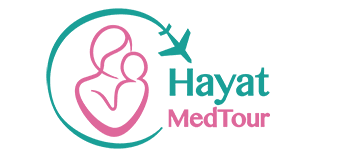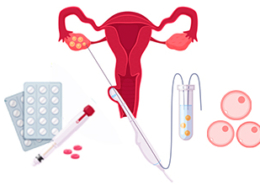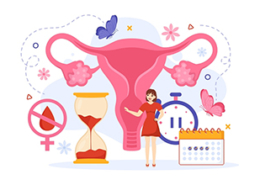Egg Retrieval in IVF: Process, Steps, and Aftercare
Treating infertility is a challenging but promising step in the lives of many couples, and in vitro fertilization (IVF) is one of the best ways to achieve this goal. A key step in the IVF process, called oocyte retrieval, plays a vital role in the success of the treatment. In this step, mature eggs are collected from the ovaries to be fertilized with sperm in the laboratory.
IVF egg retrieval can be emotionally complex and even scary. However, knowing and understanding the process can help alleviate your worries, enhance your mental and physical preparedness, and make you feel more in control. In this article, we will focus on the egg retrieval stage of IVF to guide you through your fertility journey and provide you with the information you need to take the next steps with confidence.
What is egg retrieval in IVF?
Egg retrieval is a key step in the IVF process, during which mature eggs are removed from the ovaries and used for fertilization with sperm in the laboratory. Before egg retrieval, you will need to go through the following steps to prepare your body for the procedure:
1. Stimulation of the ovaries
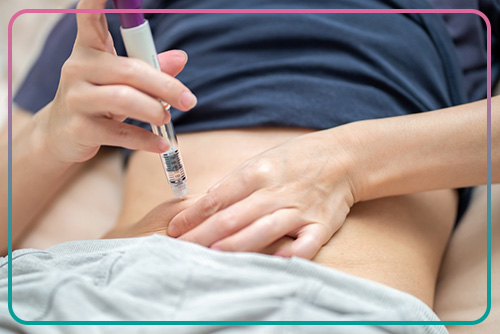
Under normal conditions, several ovarian follicles grow during each menstrual cycle, but only one reaches full maturity and is released from the ovary during ovulation.
By administering ovulation‑stimulating drugs such as follicle‑stimulating hormone (FSH) and luteinizing hormone (LH), more ovarian follicles can grow and reach full maturity. These drugs are usually started on Day 2 or 3 of the menstrual cycle and continued for about 10–12 days under the supervision of a specialist. This process makes it possible to collect more eggs. As the number of collected eggs increases, so does the number of resulting embryos, which ultimately improves the chances of pregnancy.
2. Monitoring Follicle Growth
Timing is very important in IVF. If the egg retrieval is done too early or too late, the eggs may not reach full maturity or may not be of the required quality. Therefore, the doctor regularly monitors the status of egg growth through ultrasound and blood tests.
3. Egg collection
Before this stage begins, you will receive an injection of a hormone called human chorionic gonadotropin (hCG), which helps the eggs mature and be released. Approximately 36 hours after this injection, a specialist will perform the egg retrieval procedure. In this stage, which is usually done under light anesthesia, the doctor will use a special needle and ultrasound to remove the eggs from your body through the Follicular fluid. After the collection, the eggs are sent to an embryology laboratory for preparation and then insemination with a sperm sample.
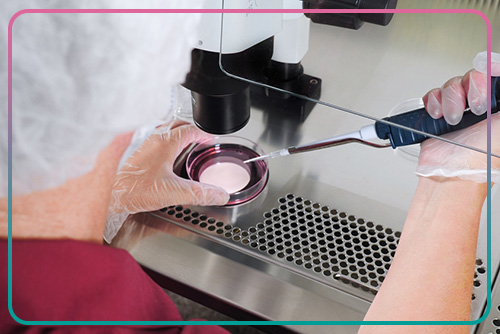
Egg retrieval in IVF: A step-by-step guide
Egg retrieval is one of the most important steps in the IVF process. During this step, your doctor removes mature eggs from your ovaries to prepare them for fertilization in the lab. Below, we explain the entire process of egg retrieval from pre-procedure preparation to post-procedure care step by step.
Preparing for the procedure
The following tips will help you be in a good physical and mental condition for the egg retrieval procedure:
1. Medical preparations
Before the egg retrieval procedure, it is necessary to perform some tests, including checking blood clotting factors and checking HIV and hepatitis status, to ensure the body is ready for anesthesia.
Discuss any underlying medical conditions, such as diabetes, thyroid problems, heart disease, etc., with your doctor, and provide a list of all medications and supplements you are taking. You may need to stop taking some medications before the procedure.
2. Health and personal care
On the morning of the procedure, be sure to take a shower and trim your pubic hair. You will also need to eat a light dinner at 8 pm and fast from 12 pm until the procedure. On the day of the procedure, you are not allowed to wear any makeup, nail polish, body lotion, hair gel, or gold or jewelry. It is also recommended that you wear glasses instead of contact lenses on this day.
3. Attendance at the treatment center and administrative arrangements
Return to the infertility treatment center 1 to 2 hours before the scheduled time to allow enough time to complete administrative procedures, complete consent forms, and make final checks.
4. Anesthesia for IVF and the need for a companion
Since the IVF egg retrieval process is usually performed under anesthesia, a companion is required on the day of the procedure. The anesthesia used is often light and is intended to create complete relaxation and prevent pain.
Egg retrieval process
After the ovaries are stimulated using prescribed hormonal drugs, these organs enlarge to the point where they can be easily placed near the vaginal wall. This allows the doctor to examine the ovaries using ultrasound and collect the eggs through the vaginal wall.
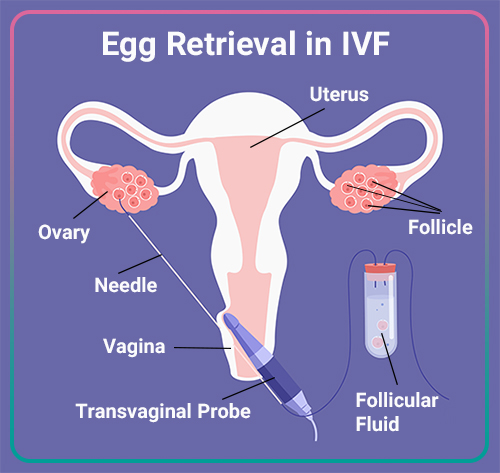
During this procedure, the doctor can view the ovaries on an ultrasound monitor and remove the eggs using a special fine needle and suction. This procedure, called transvaginal ultrasound-guided aspiration, takes 10 to 20 minutes.
Egg collection is done laparoscopically in some cases. In this procedure, the doctor views the ovaries using a laparoscope and removes the eggs directly from them.
Although egg retrieval can be a source of anxiety for some people, it has few side effects and does not reduce ovarian reserve in any way. Additionally, post-ovulatory pain is usually very mild and can be controlled with prescribed medications.
Initial Postoperative Care
After ovulation induction, you will usually wake up immediately. At this stage, you may have some discomfort or mild pain in the pelvic or abdominal area, which can be easily controlled with painkillers prescribed by your doctor.
In the first few hours after the procedure, rest and self-care are very important. You can leave the treatment center after 2 to 3 hours of rest. However, you should have relative rest for at least 48 hours and avoid strenuous activities.
Post-Oocyte Retrieval Care
After the egg retrieval procedure, your body needs some rest and special care. Following simple medical advice at this stage will not only reduce discomfort but also speed up the recovery process and help ensure the success of your IVF treatment.
1. Common Symptoms and Complications after the Egg Retrieval Procedure
After egg retrieval, symptoms may occur that are usually temporary and improve with proper care. These symptoms include:
- Mild abdominal cramping and pain: Pain from Oocyte retrieval is often controlled with painkillers. However, in severe cases, a doctor should be consulted.
- Spotting or light bleeding: You may experience spotting or light bleeding for the first 1 to 2 days after egg retrieval. This is normal, but if it is severe, you should report it to your doctor immediately.
- Nausea or dizziness: Mild nausea or dizziness in the first 24 hours after surgery is temporary and related to the anesthesia. However, if these symptoms persist, you should contact your doctor.
2. Strategies to speed up recovery
Rest and hygiene are essential to speed up the recovery process. The most important post-IVF care is listed below:
- Get enough rest: Rest for 48 hours after ovulation and avoid heavy activities. After one to two weeks, when the ovaries have returned to their normal size, you can gradually start exercising with the advice of your doctor.
- Pain management: If you feel pain, take painkillers prescribed by your doctor.
- Fluid intake: Drink plenty of fluids throughout the day to keep yourself hydrated.
- Genital care: Your doctor may prescribe antibiotics to prevent infection. Take any prescribed medications as directed.
- Abstaining from sex: Avoid sex for 2 weeks after ovulation.
- Nutritional care: Eat a balanced and varied diet high in fiber and protein, and limit caffeine and sugary snacks.
3. When should you call your doctor?
If the side effects are severe, call your doctor right away. Side effects that require treatment include:
- Fever over 38°C
- Heavy vaginal bleeding
- Pain or difficulty urinating
- Severe swelling or pain in the abdomen
- Severe nausea
- Symptoms of ovarian hyperstimulation syndrome (OHSS) include pain, nausea, vomiting, diarrhea, and shortness of breath
4. Emotional Support IVF
The infertility treatment process can have significant emotional and psychological impacts and can even lead to mood swings, anxiety, and depression at various stages.

Addressing physical and psychological needs, such as getting enough rest, eating well, and engaging in relaxing activities, can help improve your mood. Also, establishing close relationships with your spouse, family, and friends can reduce feelings of loneliness and boost self-confidence.
Factors affecting egg retrieval success
The success of IVF oocyte retrieval and achieving an adequate number of high-quality eggs is influenced by several factors, including:
- Age and ovarian reserve: Increasing age is associated with decreased egg quality and quantity. The younger you are at the time of IVF, the higher your chances of getting pregnant.
- Body response to ovulation induction drugs: The body’s response to drugs can vary from person to person. Some women may respond better to these drugs and produce more eggs.
- Lifestyle: Maintaining a healthy weight, getting enough sleep, avoiding smoking, alcohol, and drugs, and reducing caffeine can increase your chances of getting pregnant.
- General health status and cause of infertility: People with severe endometriosis have a lower chance of getting pregnant than those with an unknown cause of infertility. Taking certain medications can also make it harder to get pregnant.
Why Choose Iran for IVF?
1. Cost Benefits
The cost of each IVF treatment cycle in developed countries is around $10,000 to $15,000; in Middle Eastern countries, it is around $5,000 to $6,000. However, the cost in Iran is significantly lower. The availability of affordable IVF, along with the high quality of medical services in Iran, has made the country an attractive destination for infertile couples. The exact cost of IVF in Iran can vary from around $2,500 to $4,500, depending on various factors such as the medications used, the number of ultrasounds and tests required, the doctor’s experience, the services provided by the clinic, etc. Learn more about the cost of IVF in Iran: IVF Treatment Cost in Iran
2. Quality of care and expertise.
Iran is one of the best countries in the world in the field of infertility treatment. Because its specialist doctors can provide the best treatments to patients using the latest techniques. Iranian medical tourism centers attract numerous foreign patients every year due to the presence of experienced doctors and the use of advanced technologies. In this country, it is possible to select the gender (PGD) and freeze the embryos for couples legally. Also, if the conditions of the uterus and ovaries are suitable, the entire IVF treatment process can be done in one session (without the need to freeze the embryos after collecting the eggs), which saves time and cost.
3. Cultural and Hospitality Benefits
Iran is safe and has the right infrastructure for international travel. The best fertility clinics in Iran help patients go through their treatment process without any worries by providing support services, including the presence of experienced translators, airport pick-up, and proper accommodation. These comprehensive services provide a unique and stress-free experience for patients, making Iran an ideal destination for infertility treatment.
Emotional and Psychological Aspects of Egg Retrieval.
It is normal to feel stressed, anxious, and worried before your egg retrieval. However, managing these emotions is important for the success of your treatment. Steps that can help with emotional recovery include:
- Doing calming activities: Praying, meditation, and deep breathing can reduce stress and promote feelings of calm.

- Emotional support from your spouse and family: The presence and company of your spouse and other family members can reduce feelings of loneliness and greatly alleviate treatment-related concerns.
- Counseling and joining support groups: Sometimes, counseling with a psychologist is necessary to better manage your emotions and concerns. Also, joining support groups and meeting people who have had similar experiences can enhance empathy and emotional support.
Answers to Common Questions and Concerns About Ovulation Cryopreservation
1. What are the Risks of Ovulation Cryopreservation?
Like any other medical procedure, ovulation cryopreservation may carry risks, the most common of which are mild abdominal pain and cramping, spotting, infection, and damage to surrounding tissues.
Ovarian hyperstimulation syndrome is one of the most serious risks of IVF. This problem occurs when the ovaries overreact to the prescribed medications and become very large and painful due to the production of too many eggs.
Ovarian hyperstimulation syndrome is characterized by bloating, lower abdominal pain, nausea, vomiting, diarrhea, and shortness of breath, and should be treated immediately. If you experience symptoms of OHSS, contact your doctor immediately. Fortunately, OHSS is rare today because doctors are more experienced in prescribing IVF medications and controlling the dosage of medications.
2-Is the egg retrieval painful?
Egg retrieval is performed under light anesthesia and is, therefore, painless. However, you may feel some pain or discomfort in the vaginal area or lower abdomen after the procedure. This pain is usually mild and will improve within 1-2 days with rest and painkillers.
3-How many eggs are typically collected?
To increase the chances of IVF success, it is usually recommended to collect 10 to 15 mature eggs. However, the number of eggs for IVF can vary depending on various factors such as age, ovarian reserve, and response to ovulation induction medications.
4-What happens to the eggs after ovulation?
After ovulation, semen is collected from the person’s partner to separate the healthy sperm. The eggs and sperm are then placed together under special conditions to allow fertilization to occur and an embryo to form. The embryos are then transferred to the uterus through a thin tube through the vagina.
If the number of formed embryos is large, after transferring the embryos to the uterus, some of the remaining embryos are frozen according to the doctor’s diagnosis and with the consent of the couple, so that they can be used in case of needing to repeat the treatment cycle. learn more about the IVF process details: IVF process step by step
5. How long after egg retrieval can embryo transfer be performed?
If the ovarian and uterine conditions are suitable, embryo transfer is possible 3 to 5 days after oocyte retrieval. If the conditions are not favorable, the embryos are frozen so that their transfer can be performed after a few months.
6. How does age affect oocyte retrieval?
As you age, your ovarian reserve and egg quality decrease, which affects the chances of IVF success.
7. What happens if the body does not respond to ovulation induction drugs?
In this situation, alternative methods such as egg donation can be used. In this method, high-quality eggs are taken from another person and, after fertilization with the partner’s sperm, are transferred to the recipient’s uterus. Learn more about IVF with egg donation: Egg Donation in Iran
8. Can I return to my country immediately after the collection procedure?
In most cases, you can start your trip after 1 to 2 days of rest, and if your general condition is favorable. Of course, it is essential to consult a doctor before deciding to return.
Conclusion: Take the next step with confidence
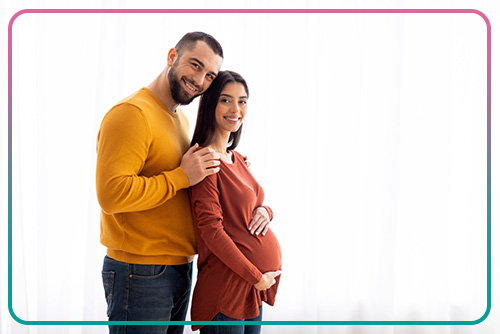
Ovulation retrieval in IVF is a vital step in infertility treatment, performed after the use of ovarian stimulation drugs and in a 10-20 minute procedure. Although the process is generally considered safe, expert advice before it is performed is of great importance. Proper advice minimizes the risk of side effects and helps you make the best decision with full knowledge of the available treatment options.
Due to the use of advanced technologies and the benefit of experienced specialists, Iran can provide the best services in expert advice, fertility assessment, and precise execution of the IVF process.
Your journey towards parenthood begins with a single step. We are here to help you on this path.
References:
Complete Guide to Egg Retrieval
What to Know about Exercising During and After an Egg Retrieval Cycle?
